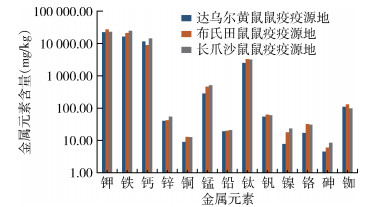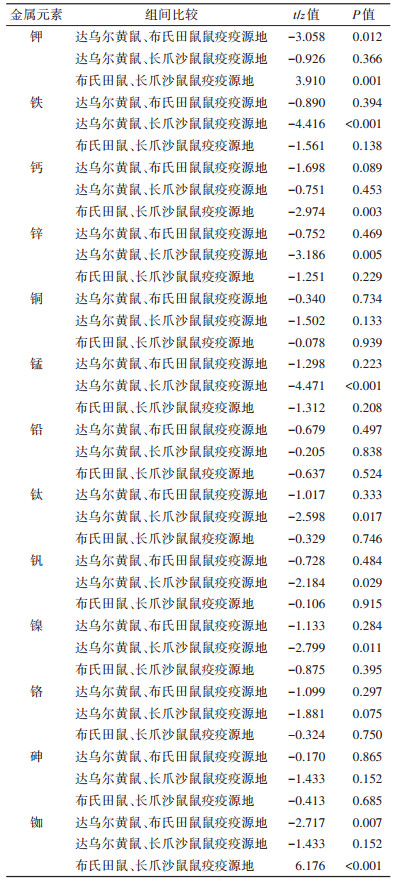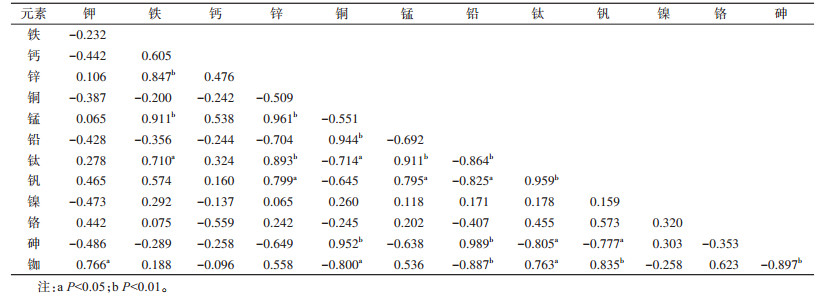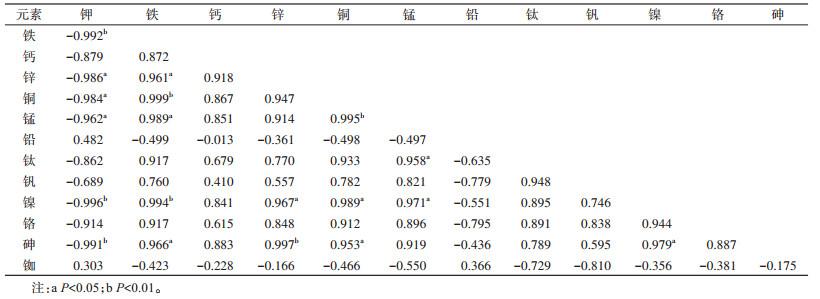扩展功能
文章信息
- 杨普伊, 李建云, 张喆
- YANG Pu-yi, LI Jian-yun, ZHANG Zhe
- 内蒙古自治区不同类型鼠疫自然疫源地土壤金属元素含量调查分析
- Analysis of the content of metal elements in soil of different types of natural plague foci in Inner Mongolia Autonomous Region, China
- 中国媒介生物学及控制杂志, 2022, 33(6): 900-905
- Chin J Vector Biol & Control, 2022, 33(6): 900-905
- 10.11853/j.issn.1003.8280.2022.06.025
-
文章历史
- 收稿日期: 2022-07-09
2 内蒙古自治区综合疾病预防控制中心 传染病预防控制一所, 内蒙古 呼和浩特 010031
2 First Department of Infectious Disease Prevention and Control, Inner Mongolia Center for Disease Control and Prevention, Hohhot, Inner Mongolia 010031, China
内蒙古自治区(内蒙古)是我国第3大省份,位于北部边疆,东西跨度大,呈狭长形,全区以高原型地貌为主。内蒙古存在4种不同类型的鼠疫自然疫源地[1],分别为长爪沙鼠(Meriones unguiculatus)、达乌尔黄鼠(Spermophilus dauricus)、布氏田鼠(Microtus brandti)以及蒙古旱獭(Marmaota sibibirica)鼠疫疫源地。
内蒙古长爪沙鼠鼠疫疫源地分布于乌兰察布市、锡林郭勒盟、鄂尔多斯市、包头市以及呼和浩特市[2],主要宿主动物为长爪沙鼠,鼠间疫情处于持续流行状态。内蒙古达乌尔黄鼠鼠疫疫源地分布于通辽市、赤峰市、兴安盟和锡林郭勒盟[2],主要宿主动物为达乌尔黄鼠。内蒙古布氏田鼠鼠疫疫源地位于阿巴嘎熔岩台地和珠穆沁盆地西部[2],主要宿主动物为布氏田鼠。近20年间,达乌尔黄鼠鼠疫疫源地和布氏田鼠鼠疫疫源地动物间疫情一直处于静息状态[3]。1926年至今,蒙古旱獭鼠疫疫源地未监测到动物间鼠疫,且与长爪沙鼠鼠疫疫源地并无接壤,而长爪沙鼠、达乌尔黄鼠和布氏田鼠鼠疫疫源地三者之间彼此接壤,交叉面积不断增大[4],但鼠间鼠疫流行情况却不相同,这可能与不同类型鼠疫自然疫源地的生态地理景观有关,其中土壤保存学说一直受到学术界的广泛关注[5]。因此,本实验对3种不同类型鼠疫自然疫源地的土壤进行采样检测,对比分析土壤中金属元素含量的差异,探究鼠疫疫情流行与土壤金属元素含量的关系,为土壤保存学说提供理论依据。
1 材料与方法 1.1 土壤样品来源查阅历史资料,选择暴发过鼠疫的监测点作为采样点,每个点面积为40 000 m2,按照梅花点法进行采样,为便于标记样品,以1点为中心,东、南、西、北4个方向共采集5份土壤样本,每份间隔至少100 m。2021年9月,分别在内蒙古达乌尔黄鼠鼠疫疫源地、布氏田鼠鼠疫疫源地、长爪沙鼠鼠疫疫源地的26个采样点采集土壤样品,每个点采集5份,共采集130份,其中达乌尔黄鼠鼠疫疫源地40份、布氏田鼠鼠疫疫源地20份、长爪沙鼠鼠疫疫源地70份。见表 1。

|
TrueX 200S型手持式X射线荧光分析仪、样品杯(苏州浪声科学仪器有限公司),BS-224S型电子天平[赛多利斯科学仪器(北京)有限公司],100目尼龙筛,陶瓷研钵和塑料自封袋。
1.3 样品采集去除地表植被,采集离地面约0~20 cm的土壤,每份土壤至少采集150 g,装入带塞无色聚乙烯塑料瓶中带回实验室。
1.4 样品处理将土样倒在已编号的无色聚乙烯薄膜上,摊平并去除植物根茎、虫体和石块等杂质,置于干燥阴凉处自然晾干,用陶瓷研钵研磨,100目尼龙筛过筛,过筛后的土样装入自封袋待测。
1.5 金属元素检测方法根据预实验以及刘琦[6]的方法略作调整,将电感耦合等离子体发射光谱仪(ICP-OES)测量值作为标准值,当自然风干的土壤样品粒径为100目,检测时间为30 s时,TrueX 200S手持式X射线荧光分析仪测量值与标准值之间误差率均 < 10%。由于前种检测方法消解过程复杂且可对人体和环境造成伤害和污染,因此选择TrueX 200S手持式X射线荧光分析仪进行本实验土壤金属元素含量的检测。取15 g待测土样装入样品杯中压实,用TrueX 200S手持式X射线荧光分析仪检测每份土样中的钾(K)、铁(Fe)、钙(Ca)、锌(Zn)、铜(Cu)、锰(Mn)、铅(Pb)、钛(Ti)、钒(V)、镍(Ni)、铬(Cr)、砷(As)和铷(Rb)的含量,平行测量5次,计算平均值。
1.6 统计学分析应用Excel 2021软件录入并整理数据,SPSS 20.0软件对数据进行统计分析。计量资料是正态分布,用均数和标准差表示,采用独立样本t检验进行两组间的比较;计量资料是偏态分布,用中位数和四分位数表示,采用Mann-Whitney U检验进行两组间的比较,采用Pearson相关对各鼠疫疫源地内的土壤金属元素含量之间进行相关性分析。
2 结果 2.1 不同类型鼠疫自然疫源地土壤金属元素含量分析不同鼠疫疫源地土壤中金属元素含量用中位数表示,金属元素含量单位为mg/kg。3种类型鼠疫疫源地土壤中富含钾、铁、钙等金属元素,布氏田鼠鼠疫疫源地土壤中钾、铜、钛、钒、铬、铷元素含量高于长爪沙鼠鼠疫疫源地和达乌尔黄鼠鼠疫疫源地,长爪沙鼠鼠疫疫源地土壤中铁、钙、锌、锰、铅、镍、砷元素含量高于达乌尔黄鼠鼠疫疫源地和布氏田鼠鼠疫疫源地。见图 1。

|
| 注:金属元素含量用中位数表示。 图 1 内蒙古自治区不同类型鼠疫自然疫源地各土壤样品金属元素含量统计 Figure 1 Metal element content in soil samples from different types of natural plague foci in Inner Mongolia Autonomous Region |
| |
铜、铬、砷元素含量在3类鼠疫疫源地之间差异均无统计学意义(均P > 0.05)。达乌尔黄鼠鼠疫疫源地与布氏田鼠鼠疫疫源地比较,钾、铷元素含量差异有统计学意义(均P < 0.05),其余金属元素含量差异无统计学意义(均P > 0.05);达乌尔黄鼠鼠疫疫源地与长爪沙鼠鼠疫疫源地比较,铁、锌、锰、钛、钒、镍元素含量差异有统计学意义(均P < 0.05);布氏田鼠鼠疫疫源地与长爪沙鼠鼠疫疫源地比较,除钾、钙、铷元素含量差异有统计学意义外(均P < 0.05),其余元素差异均无统计学意义(均P > 0.05)。见表 2。

|
达乌尔黄鼠鼠疫疫源地相关系数绝对值(|r|)在0.065~0.989,其中钾与铷,铁与锌、锰、钛,锌与锰、钛、钒元素含量之间存在相关性;布氏田鼠鼠疫疫源地|r|在0.013~0.999,其中钾元素含量与铁、锌、铜、锰元素含量之间存在相关性;长爪沙鼠鼠疫疫源地|r|在0.008~0.912,其中铁与锌、铜、锰、钛、砷元素含量之间存在相关性。达乌尔黄鼠和布氏田鼠鼠疫疫源地,钙与其他金属元素,铬与其他金属元素含量之间均无相关性,长爪沙鼠鼠疫疫源地,钙与铅元素含量之间呈负相关,其余元素含量相关性见表 3~5。

|

|

|
鼠疫是由鼠疫耶尔森菌(Yersinia pestis,鼠疫菌)引起的一种传染性极强的自然疫源性疾病,该疾病的暴发流行与宿主、媒介以及当地的生态地理景观存在一定关联[7]。土壤作为地理景观要素之一,与鼠疫菌的保存机制密切相关[8]。研究发现,在非寄生条件下,鼠疫菌能在土壤中保持毒性并长时间存活,存活时间长达280 d,而鼠疫菌在钢铁或玻璃上的存活时间不到72 h[9]。魏有文等[10]发现,拥有相同地理景观和海拔高度的2种鼠疫自然疫源地疫情状况却不相同,高发区土壤金属元素含量均高于静息区。李瑞[11]调查的云南省鼠疫自然疫源地发现,疫村土壤中镍、钒含量高于非疫村,因此对不同类型鼠疫自然疫源地的土壤特性进行调查非常必要。
啮齿类动物中出现鼠疫的原因与土壤中某些金属元素的含量剧烈变化有关。研究报道,当土壤中的钛、铁、钴3种金属元素的含量迅速增至正常水平的3倍时,达乌尔黄鼠和长爪沙鼠中便会暴发鼠疫[9]。此外,当土壤中的铜、镍、钒3种金属元素的含量急剧降至正常水平的1/12,而其他金属离子含量仍保持正常时,鼠群中同样会暴发鼠疫。鼠疫菌可利用部分金属元素增强致病力。给感染Pst-鼠疫菌或者Pgm-鼠疫菌的小鼠补充高剂量的铁,可使鼠疫菌恢复致病力导致小鼠发病[12]。鼠疫菌产生一种称为耶尔森菌素(Ybt)的铁载体,它对Fe3+有高亲和力,可从环境和宿主体内摄取铁,维持自身的致病能力[13-14]。研究表明,铁硫簇协同转录因子IscR利用Fe-S簇蛋白感知铁的可用性,从而调节鼠疫菌Ⅲ型分泌系统[15-16]。当外界铁的浓度很低时,鼠疫菌利用TonB转运系统提高铁的摄取效率,从而维持自身生存和繁殖能力[17]。通过对鼠疫菌KIM10+基因组的研究发现,ZnuABC转运体是鼠疫菌唯一的锌摄取系统,当该系统缺乏时,Ybt可与锌结合,促进鼠疫菌的生长[18]。
近20年来,内蒙古长爪沙鼠鼠疫疫源地鼠间疫情不断甚至出现人间病例,而与之接壤的布氏田鼠鼠疫疫源地和达乌尔黄鼠鼠疫疫源地却处于静息状态,针对这一现象,本实验围绕鼠疫疫源地土壤中的金属元素含量展开研究,发现长爪沙鼠鼠疫疫源地铁、钙含量均高于其他2个鼠疫疫源地,这与铁可增强Pst-鼠疫菌或者Pgm-鼠疫菌致病力以及钙对鼠疫菌的生长有促进作用相符合[19-20];周芸和尹家祥[21]研究发现,细菌摄入的各种金属元素含量都经过严格调控,过量或者缺乏对细菌的生存繁殖都是不利的。在长爪沙鼠鼠疫疫源地,铁与锌、铜、锰、钛、钒、铬、砷、铷呈正相关,钙与铅呈负相关,在其他疫源地无相关性;在达乌尔黄鼠鼠疫疫源地和布氏田鼠鼠疫疫源地,铁与钒、铬无相关性;说明铁和钙的含量可能分别受到锌、铜、锰、钛、钒、铬、砷、铷以及铅的影响,其中钒、铬、铅可能与长爪沙鼠鼠疫疫源地疫情不断有关系。
本次研究通过检测内蒙古不同类型鼠疫自然疫源地土壤金属元素含量,分析土壤金属元素分布差异以及相关性,探究金属元素变化与鼠疫疫情之间的联系,提示需长期动态监测土壤中金属元素含量变化,为内蒙古鼠疫自然疫源地土壤金属元素含量提供基线资料,对完善鼠疫防控策略起到积极作用,为进一步研究鼠疫菌的保存机制提供理论依据。
利益冲突 无
| [1] |
刘纪有, 张万荣. 内蒙古鼠疫[M]. 呼和浩特: 内蒙古人民出版社, 1997: 84. Liu JY, Zhang WR. Pestis in Inner Mongolia[M]. Hohhot: Inner Mongolia People's Publishing House, 1997: 84. |
| [2] |
方喜业. 中国鼠疫自然疫源地[M]. 北京: 人民卫生出版社, 1990: 26. Fang XY. Natural focuses of plague in China[M]. Beijing: People's Medical Publishing House, 1990: 26. |
| [3] |
段天一. 1997-2016年内蒙古自治区长爪沙鼠鼠疫自然疫源地鼠疫监测流行病特征分析[D]. 长春: 吉林大学, 2018. Duan TY. Analysis on epidemic characteristics of plague monitoring in natural foci of Mongolian gerbil in Inner Mongolia Autonomous Region from 1997 to 2016[D]. Changchun: Jilin University, 2018. (in Chinese) |
| [4] |
贺兆锴. 旱獭、长爪沙鼠、齐氏姬鼠-大绒鼠鼠疫自然疫源地鼠疫流行特征研究[D]. 北京: 中国疾病预防控制中心, 2021. DOI: 10.27511/d.cnki.gzyyy.2021.000082. He ZK. Research on plague epidemic characteristics of plague natural foci of marmota, Meriones unguiculatus and Apodemus chevrieri-Eothenomys miletus[D]. Beijing: Chinese Center for Disease Control and Prevention, 2021. DOI: 10.27511/d.cnki.gzyyy.2021.000082.(in Chinese) |
| [5] |
邴琪, 王照, 关心. 鼠疫菌保存机理研究进展[J]. 中国地方病防治, 2021, 36(6): 588-590. Bing Q, Wang Z, Guan X. Research progress on the preservation mechanism of Yersinia pestis[J]. Chin J Ctrl Endem Dis, 2021, 36(6): 588-590. |
| [6] |
刘琦. 便携式X射线荧光仪分析土壤中重金属的方法研究[D]. 西安: 西安科技大学, 2017. Liu Q. Portable X-ray fluorescence analyzer test spectrometer analysis of heavy metals in soil[D]. Xi'an: Xi'an University of Science and Technology, 2017. (in Chinese) |
| [7] |
王秀芳, 尹家祥. 鼠疫复燃因素的分析[J]. 中华地方病学杂志, 2014, 33(1): 116-118. Wang XF, Yin JX. Analysis on the factors of pestis resurgence[J]. Chin J Endemiol, 2014, 33(1): 116-118. DOI:10.3760/cma.j.issn.2095-4255.2014.01.038 |
| [8] |
李瑞, 尹家祥. 生态地理景观要素土壤与鼠疫的关系[J]. 中国人兽共患病学报, 2020, 36(10): 876-880. Li R, Yin JX. Relationship between the soil element in eco-geographical landscape and the occurrence of plague[J]. Chin J Zoonoses, 2020, 36(10): 876-880. DOI:10.3969/j.issn.1002-2694.2020.00.125 |
| [9] |
Barbieri R, Signoli M, Chevé D, et al. Yersinia pestis: The natural history of plague[J]. Clin Microbiol Rev, 2020, 34(1): e00044-19. DOI:10.1128/CMR.00044-19 |
| [10] |
魏有文, 陈洪舰, 孟献亚, 等. 青海青南地区鼠疫自然疫源地鼠疫高发区与静息区土壤中12种金属元素含量分析[J]. 中华地方病学杂志, 2021, 40(12): 947-952. Wei YW, Chen HJ, Meng XY, et al. Contents of 12 soil metal elements in the plague high incidence area and resting area in the plague natural foci of Qingnan region of Qinghai province[J]. Chin J Endemiol, 2021, 40(12): 947-952. DOI:10.3760/cma.j.cn231583-20210203-00116 |
| [11] |
李瑞. 云南家鼠鼠疫疫源地三县(市)地表土壤特性研究[D]. 大理: 大理大学, 2021. DOI: 10.27811/d.cnki.gdixy.2021.000235. Li R. Study on surface soil characteristics of commensal rodent plague foci in three counties of Yunnan province[D]. Dali: Dali University, 2021. DOI: 10.27811/d.cnki.gdixy.2021.000235.(in Chinese) |
| [12] |
史书文, 樊振亚. 铁对缺失外膜蛋白质(E. J)或Pst-鼠疫菌增强毒力的作用[J]. 中国地方病防治杂志, 1991, 6(3): 162-163. Shi SW, Fan ZY. The role of iron in enhancing the virulence of absence of outer membrane protein (E. J) or Pst- pestis[J]. Chin J Ctrl Endem Dis, 1991, 6(3): 162-163. |
| [13] |
Chen YL, Song K, Chen X, et al. Attenuation of Yersinia pestis fyuA mutants caused by iron uptake inhibition and decreased survivability in macrophages[J]. Front Cell Infect Microbiol, 2022, 12: 874773. DOI:10.3389/fcimb.2022.874773 |
| [14] |
陈雨露, 宋凯, 焦扬, 等. 鼠疫耶尔森菌铁转运系统研究进展[J]. 军事医学, 2021, 45(11): 868-872. Chen YL, Song K, Jiao Y, et al. Research progress on iron transport system of Yersinia pestis[J]. Mil Med Sci, 2021, 45(11): 868-872. DOI:10.7644/j.issn.1674-9960.2021.11.014 |
| [15] |
Balderas D, Mettert E, Lam HN, et al. Genome scale analysis reveals IscR directly and indirectly regulates virulence factor genes in pathogenic Yersinia[J]. mBio, 2021, 12(3): e0063321. DOI:10.1128/mBio.00633-21 |
| [16] |
Hooker-Romero D, Mettert E, Schwiesow L, et al. Iron availability and oxygen tension regulate the Yersinia Ysc type Ⅲ secretion system to enable disseminated infection[J]. PLoS Pathog, 2019, 15(12): e1008001. DOI:10.1371/journal.ppat.1008001 |
| [17] |
廖何斌, 刘马峰, 程安春. 部分革兰氏阴性菌TonB蛋白的结构特点及作用机制[J]. 微生物学报, 2015, 55(5): 529-536. Liao HB, Liu MF, Cheng AC. Structural features and functional mechanism of TonB in some Gram-negative bacteria: A review[J]. Acta Microbiol Sin, 2015, 55(5): 529-536. DOI:10.13343/j.cnki.wsxb.20140530 |
| [18] |
Price SL, Vadyvaloo V, DeMarco JK, et al. Yersiniabactin contributes to overcoming zinc restriction during Yersinia pestis infection of mammalian and insect hosts[J]. Proc Natl Acad Sci USA, 2021, 118(44): e2104073118. DOI:10.1073/pnas.2104073118 |
| [19] |
Perry RD, Fetherston JD. Yersiniabactin iron uptake: Mechanisms and role in Yersinia pestis pathogenesis[J]. Microbes Infect, 2011, 13(10): 808-817. DOI:10.1016/j.micinf.2011.04.008 |
| [20] |
浦清江, 张春华. 鼠疫耶尔森氏菌外膜蛋白研究进展[J]. 中国地方病防治杂志, 2005, 20(5): 276-278. Pu QJ, Zhang CH. Research progress of outer membrane protein of Yersinia pestis[J]. Chin J Ctrl Endem Dis, 2005, 20(5): 276-278. |
| [21] |
周芸, 尹家祥. 金属元素铁锌锰铜与传染性疾病的关系[J]. 职业与健康, 2017, 33(13): 1869-1872. Zhou Y, Yin JX. Relationship between infectious diseases and metal elements of iron, zinc, manganese and copper[J]. Occup Health, 2017, 33(13): 1869-1872. DOI:10.13329/j.cnki.zyyjk.2017.0564 |
 2022, Vol. 33
2022, Vol. 33


